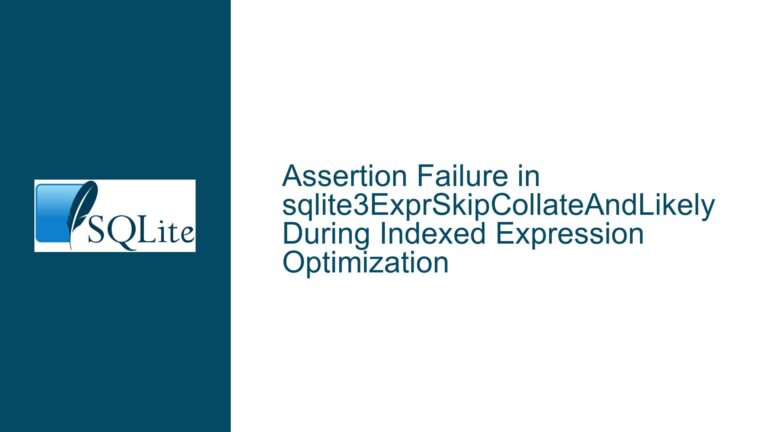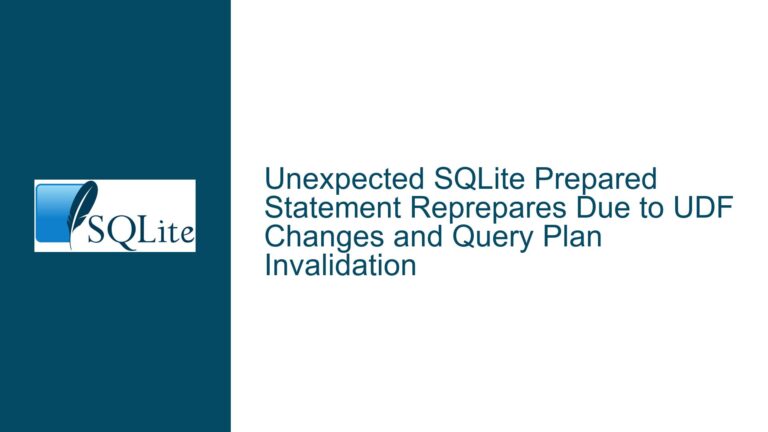Enabling SQLITE_STAT4 for Optimized Range-Scan Estimation in SQLite
Understanding the Role of SQLITE_STAT4 in Query Optimization
SQLite is a lightweight, embedded relational database management system that is widely used due to its simplicity, efficiency, and portability. One of the key features that contribute to SQLite’s performance is its query optimizer, which is responsible for determining the most efficient way to execute a given SQL query. The optimizer relies on various statistics and metadata to make informed decisions about query execution plans. Among these, the SQLITE_STAT4 feature plays a crucial role in optimizing range-scan queries.
The SQLITE_STAT4 feature enhances the query optimizer’s ability to estimate the number of rows that will be visited during a range scan on a multi-column index. This is particularly important for queries that involve skip-scan indexes, where the optimizer needs to estimate the selectivity of range conditions on non-leading columns of an index. Without SQLITE_STAT4, the optimizer may make less accurate estimates, leading to suboptimal query plans and potentially slower query execution.
The SQLITE_STAT4 feature is implemented in the where.c file of the SQLite source code, specifically within the whereRangeSkipScanEst function. This function is responsible for estimating the number of rows that will be visited during a range scan on a skip-scan index. The function uses statistical data stored in the sqlite_stat4 table to make these estimates. However, for this function to be compiled and available in your SQLite build, the SQLITE_ENABLE_STAT4 preprocessor symbol must be defined during the compilation process.
The Necessity of Defining SQLITE_ENABLE_STAT4 During Compilation
The SQLITE_ENABLE_STAT4 preprocessor symbol is a compile-time flag that determines whether the SQLITE_STAT4 feature is included in the SQLite build. When this flag is defined, the code within the #ifdef SQLITE_ENABLE_STAT4 block in the where.c file is included in the compilation process. This code includes the whereRangeSkipScanEst function, which is essential for optimizing range-scan queries using the sqlite_stat4 table.
If the SQLITE_ENABLE_STAT4 flag is not defined, the code within the #ifdef SQLITE_ENABLE_STAT4 block is excluded from the compilation. As a result, the whereRangeSkipScanEst function will not be available, and the query optimizer will not be able to use the sqlite_stat4 table to make accurate estimates for range-scan queries. This can lead to suboptimal query plans, especially for complex queries involving multi-column indexes and range conditions.
The SQLITE_ENABLE_STAT4 flag is not enabled by default in standard SQLite builds. Therefore, if you require the enhanced query optimization capabilities provided by SQLITE_STAT4, you must explicitly define this flag during the compilation process. This can be done by modifying the compilation options or the Makefile used to build SQLite.
Steps to Enable SQLITE_STAT4 in Your SQLite Build
Enabling the SQLITE_STAT4 feature in your SQLite build involves defining the SQLITE_ENABLE_STAT4 preprocessor symbol during the compilation process. This can be achieved through several methods, depending on your build environment and tools. Below are the detailed steps to enable SQLITE_STAT4 in different scenarios:
1. Compiling SQLite from Source with Custom Compilation Flags
If you are compiling SQLite from source, you can define the SQLITE_ENABLE_STAT4 flag by passing it as a compilation option to the C compiler. This can be done using the -D option, which is used to define preprocessor symbols. For example, if you are using the gcc compiler, you can compile SQLite with the following command:
gcc -DSQLITE_ENABLE_STAT4 -o sqlite3 shell.c sqlite3.c
This command defines the SQLITE_ENABLE_STAT4 symbol and compiles the SQLite shell (shell.c) and the SQLite library (sqlite3.c) into an executable named sqlite3.
2. Modifying the Makefile for SQLite Builds
If you are using a Makefile to build SQLite, you can define the SQLITE_ENABLE_STAT4 flag by modifying the OPTS variable in the Makefile. The OPTS variable is used to specify additional compilation options for the build. To enable SQLITE_STAT4, add the -DSQLITE_ENABLE_STAT4 option to the OPTS variable. For example:
OPTS += -DSQLITE_ENABLE_STAT4
After modifying the Makefile, you can build SQLite by running the make command. This will compile SQLite with the SQLITE_ENABLE_STAT4 flag defined, enabling the SQLITE_STAT4 feature.
3. Using Precompiled Binaries with SQLITE_STAT4 Enabled
If you are using precompiled SQLite binaries, you need to ensure that the binaries were compiled with the SQLITE_ENABLE_STAT4 flag defined. If the precompiled binaries do not include the SQLITE_STAT4 feature, you will need to compile SQLite from source with the SQLITE_ENABLE_STAT4 flag enabled, as described in the previous steps.
4. Verifying SQLITE_STAT4 is Enabled
After compiling SQLite with the SQLITE_ENABLE_STAT4 flag, you can verify that the feature is enabled by checking the output of the sqlite3_compileoption_used function. This function returns a boolean value indicating whether a specific compile-time option was used during the compilation of the SQLite library. You can use the following SQL query to check if SQLITE_ENABLE_STAT4 is enabled:
SELECT sqlite3_compileoption_used('SQLITE_ENABLE_STAT4');
If the query returns 1, the SQLITE_ENABLE_STAT4 feature is enabled in your SQLite build. If it returns 0, the feature is not enabled, and you will need to recompile SQLite with the SQLITE_ENABLE_STAT4 flag defined.
Troubleshooting Common Issues with SQLITE_STAT4
While enabling the SQLITE_STAT4 feature is relatively straightforward, there are some common issues that you may encounter during the process. Below are some troubleshooting steps to help you resolve these issues:
1. Incorrect Compilation Flags
One of the most common issues is using incorrect or incomplete compilation flags. Ensure that the -DSQLITE_ENABLE_STAT4 flag is correctly specified during the compilation process. If you are using a Makefile, double-check that the OPTS variable includes the -DSQLITE_ENABLE_STAT4 option.
2. Missing Dependencies
The SQLITE_STAT4 feature relies on certain dependencies, such as the sqlite_stat4 table and the whereRangeSkipScanEst function. If these dependencies are not available in your SQLite build, the feature will not work as expected. Ensure that your SQLite build includes the necessary source files and that the SQLITE_ENABLE_STAT4 flag is correctly defined.
3. Incompatible SQLite Versions
The SQLITE_STAT4 feature is available in SQLite version 3.8.0 and later. If you are using an older version of SQLite, you will need to upgrade to a newer version that supports this feature. Check the SQLite version by running the following SQL query:
SELECT sqlite_version();
If the version is older than 3.8.0, consider upgrading to a newer version of SQLite.
4. Incorrect Usage of the sqlite_stat4 Table
The sqlite_stat4 table is used by the query optimizer to store statistical data for multi-column indexes. If this table is not properly populated or is missing, the SQLITE_STAT4 feature will not be able to provide accurate estimates for range-scan queries. Ensure that the sqlite_stat4 table is created and populated with the necessary statistical data. You can use the ANALYZE command to generate and update the statistics in the sqlite_stat4 table.
5. Misconfigured Query Plans
Even with the SQLITE_STAT4 feature enabled, the query optimizer may still generate suboptimal query plans if the underlying statistics are outdated or inaccurate. Regularly update the statistics in the sqlite_stat4 table using the ANALYZE command to ensure that the query optimizer has access to the most up-to-date information.
Conclusion
Enabling the SQLITE_STAT4 feature in SQLite is essential for optimizing range-scan queries, particularly those involving multi-column indexes. By defining the SQLITE_ENABLE_STAT4 preprocessor symbol during the compilation process, you can ensure that the whereRangeSkipScanEst function is included in your SQLite build, allowing the query optimizer to make more accurate estimates and generate more efficient query plans.
To enable SQLITE_STAT4, you can either pass the -DSQLITE_ENABLE_STAT4 flag directly to the compiler or modify the OPTS variable in your Makefile. After enabling the feature, verify that it is correctly enabled using the sqlite3_compileoption_used function. Additionally, ensure that the sqlite_stat4 table is properly populated with statistical data to maximize the effectiveness of the SQLITE_STAT4 feature.
By following the steps outlined in this guide, you can successfully enable and utilize the SQLITE_STAT4 feature in your SQLite build, leading to improved query performance and more efficient database operations.






